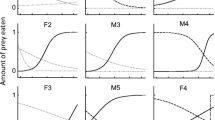Abstract
Feeding efficiency is an important factor explaining diet selection in seed-eating animals. Behavioral adaptation to process and consume the seed is advantageous to improve their feeding rate. The Japanese walnut (Juglans ailanthifolia), which has a nutritious kernel surrounded by a hard shell, is an important food for the Japanese squirrel (Sciurus lis) in lowland mixed-species forests in Japan. In the present study, population differences in feeding technique were examined. In all squirrels captured from the Takao population (with wild Japanese walnuts in their habitat), the optimal feeding technique for quickly opening the walnut shell was observed. However, only 8% of the squirrels from the Fuji population (without walnuts in their habitat) processed the walnuts by the optimal feeding technique. By a repetitive provision of walnuts for 50 days, 14% of squirrels from the Fuji population acquired the optimal feeding technique. Learning effects did not differ significantly between solitary (without a demonstrator) and social conditions (with a demonstrator). The effects of age on learning the feeding technique were examined using individuals from a zoo population that had been naïve for Japanese walnuts. All five individuals aged 6 months old, and half the individuals aged 1–2 years old, ate walnuts by the optimal feeding technique after a 2-month learning period, but none of the individuals older than 3 years did. Consequently, the walnut feeding techniques of the Japanese squirrel are not entirely genetically fixed behavior and can be improved by learning at a young age.





Similar content being viewed by others
References
Aisner R, Terkel J (1992) Ontogeny of pine cone opening behaviour in the black rat, Rattus rattus. Anim Behav 44:327–336
Clayton NS (1992) The ontogeny of food-storing and retrieval in marsh tits. Behaviour 122:11–25
Eibl-Eibesfeldt I (1951) Beobachtungen zur Fortpflanzungsbiologie und Jugendentwichlung des Eichhörnchens. Z Tierpsychol 8:370–400 (in German)
Fjellstrom RG, Parfitt DE (1994) Walnut (Juglans spp.) genetic diversity determined by restriction fragment length polymorphisms. Genome 37:690–699
Fox JF (1982) Adaptation of gray squirrel behavior to autumn germination by white oak acorns. Evolution 36:800–809
Galef BG Jr (1980) Diving for food: Analysis of a possible case of social learning in wild rats (Rattus norvegicus). J Comp Physiol Psychol 94:416–425
Galef BG Jr (1995) Why behaviour patterns that animals learn socially are locally adaptive. Anim Behav 49:1325–1334
Galef BG Jr, Giraldeau LA (2001) Social influences on foraging in vertebrates: causal mechanisms and adaptive functions. Anim Behav 61:3–15
Heyes CM (1994) Social learning in animals: categories and mechanisms. Biol Rev 69:207–231
Kataoka T, Aikyo C, Watanabe M, Tamura N (2010) Population dynamics and home ranges of the Japanese squirrel in red pine forests. Mamm Study 35:79–84
Kato J (1985) Food and hoarding behavior of Japanese squirrels. Jpn J Ecol 35:13–20
Kendal RL, Coolen I, van Bergen Y, Laland KN (2005) Trade-offs in the adaptive use of social and asocial learning. Adv Study Behav 35:333–379
Kenward B, Rutz C, Weir AAS, Kacelnik A (2006) Development of tool use in New Caledonian crows: inherited action patterns and social influences. Anim Behav 72:1329–1343
Lewis AR (1982) Selection of nuts by gray squirrels and optimal foraging theory. Am Midl Nat 107:250–257
Mazur R, Seher V (2008) Socially learned foraging behaviour in wild black bears, Ursus americanus. Anim Behav 75:1503–1508
Munoz A, Bonal R (2008) Seed choice by rodents: learning or inheritance? Behav Ecol Sociobiol 62:913–922
Nicol CJ, Pope SJ (1994) Social learning in small flocks of laying hens. Anim Behav 47:1289–1296
Numata M (1971) Vertical vegetation zones of Japanese mountains and historical review of researches on vegetation of Mt. Fuji. In: Mt. Fuji, Hydrologic study of volcano Fuji and its adjacent areas, Fujikyu Railway, Shizuoka, pp 347–370 (in Japanese)
Pyke GH, Pulliam HR, Charnov EL (1977) Optimal Foraging: a selective review of theory and tests. Q Rev Biol 55:137–154
Range F, Huber L (2007) Attention in common marmosets: implications for social-learning experiments. Anim Behav 73:1033–1041
Rymer T, Schradin C, Pillay N (2008) Social transmission of information about novel food in two populations of the African striped mouse, Rhabdomys pumilio. Anim Behav 76:1297–1304
Sasaki S (2005) 10 years of ‘squirrel woods plan’. Honyurui Kagaku (Mamm Sci) 45:63–67 (in Japanese)
Shettleworth SJ (2001) Animal cognition and animal behaviour. Anim Behav 61:277–286
Shimada T, Saito T (2006) Re-evaluation of the relationship between rodent populations and acorn masting: a review from the aspect of nutrients and defensive chemicals in acorns. Popul Ecol 48:341–352
Smith CC (1970) The coevolution of pine squirrels (Tamiasciurus) and conifers. Ecol Monogr 40:349–371
Smith CC, Follmer D (1972) Food preferences of squirrels. Ecology 53:82–91
Steele MA (2008) Evolutionary interactions between tree squirrels and trees: a review and synthesis. Curr Sci 95:871–876
Steele MA, Maniere S, Genna T, Contreras TA, Smallwood PD, Pareira ME (2006) The innate basis of food-hoarding decisions in grey squirrels: evidence for behavioural adaptations to the oaks. Anim Behav 71:155–160
Sutherland GD, Harestad AS, Price K, Lertzman KP (2000) Scaling of natal dispersal distances in terrestrial birds and mammals. Conserv Ecol 4:16
Takechi R, Tamura N, Hayashi F (2009) Improved walnut-feeding skills with experience in wood mice, Apodemus speciosus. J Ethol 27:83–89
Tamura N (1997) Japanese squirrels as a seed disperser of walnuts. Prima Res 13:129–135 (in Japanese)
Tamura N (2009) Sciurus lis Temminck, 1844. In: Ohdachi SD, Ishibashi Y, Iwasa MA, Saito T (eds) The wild mammals of Japan. Shoukadoh, Kyoto, pp 186–187
Tamura N, Hayashi F (2007) Five-year study of the genetic structure and demography of two subpopulations of the Japanese squirrel (Sciurus lis) in a continuous forest and an isolated woodlot. Ecol Res 22:261–267
Tamura N, Hayashi F (2008) Geographic variation in walnut seed size correlates with hoarding behaviour of two rodent species. Ecol Res 23:607–614
Tamura N, Shibasaki E (1996) Fate of walnut seeds, Juglans ailanthifolia, hoarded by Japanese squirrels, Sciurus lis. J For Res 1:219–222
Tamura N, Katsuki T, Hayashi F (2005) Walnut seed dispersal: mixed effects of tree squirrels and field mice with different hoarding ability. In: Forget PM, Lambert JE, Hulme PE, Vander Wall SB (eds) Seed fate. CAB International, Wallingford, pp 241–252
Tebbich S, Taborsky M, Fessl B, Blomqvist D (2001) Do woodpecker finches acquire tool-use by social learning? Proc Biol Sci 268:2189–2193
Terkel J (1996) Cultural transmission of feeding behavior in the black rat (Rattus rattus). In: Heyes CM, Galef Jr BG (eds) Social learning in animals. Academic, San Diego, pp 17–47
Thornton A, McAuliffe K (2006) Teaching in wild meerkats. Science 313:227–229
Thornton A, Raihani NJ, Radford AN (2007) Teachers in the wild: some clarification. Trends Cogn Sci 11:272–273
Wauters LA, Dhondt AA (1993) Immigration patterns and success in red squirrels. Behav Ecol Sociobiol 33:159–167
Weigl PD, Hanson EV (1980) Observational learning and the feeding behavior of the red squirrel Tamiasciurus hudsonicus: the ontogeny of optimization. Ecology 6:213–218
Yatake H, Tamura N (2001) To make guidelines for the Japanese squirrel conservation 3. Ecological studies on conserving the Japanese squirrel. Honyurui Kagaku (Mamm Sci) 41:149–157 (in Japanese)
Zohar O, Terkel J (1996) Social and environmental factors modulate the learning of pine-cone stripping techniques by black rats, Rattus rattus. Anim Behav 51:611–618
Acknowledgments
I am grateful to K. Kobayashi, S. Sasaki, K. Mizutani and other staff members of the Inokashira Park Zoo for providing study subjects, to M. Shigeta for assisting with the experiments, to N. Morihiro for identifying the plant species, and to J.L. Koprowski for reviewing the manuscript. I thank the staff of the Greenery and Nature Division, Forestry and Environment Department, Yamanashi Prefecture, and the Bureau of Environment, Tokyo Metropolitan Government for granting permission to capture squirrels at the Fuji and Takao study sites, respectively. This study was partly supported by a Grant-in-Aid for Scientific Research from the Ministry of Education, Japan. I also thank two anonymous referees for the valuable comments.
Author information
Authors and Affiliations
Corresponding author
About this article
Cite this article
Tamura, N. Population differences and learning effects in walnut feeding technique by the Japanese squirrel. J Ethol 29, 351–363 (2011). https://doi.org/10.1007/s10164-011-0267-z
Received:
Accepted:
Published:
Issue Date:
DOI: https://doi.org/10.1007/s10164-011-0267-z




